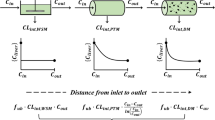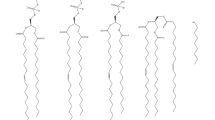Abstract
The dispersion model with mixed boundary conditions uses a single parameter, the dispersion number, to describe the hepatic elimination of xenobiotics and endogenous substances. An implicita priori assumption of the model is that the transit time density of intravascular indicators is approximated by an inverse Gaussian distribution. This approximation is limited in that the model poorly describes the tail part of the hepatic outflow curves of vasclar indicators. A sum of two inverse Gaussian functions is proposed as an alternative, more flexible empirical model for transit time densities of vascular references. This model suggests that a more accurate description of the tail portion of vascular reference curves yields an elimination rate constant (or intrinsic clearance) which is 40% less than predicted by the dispersion model with mixed boundary conditions. The results emphasize the need to accurately describe outflow curves in using them as a basis for determining pharmacokinetic parameters using hepatic elimination models.
Similar content being viewed by others
References
Bass, L., M. S. Roberts and P. J. Robinson. 1987. On the relation between extended forms of the sinusoidal perfusion and of the convection-dispersion models of hepatic elimination.J Theor. Biol. 126, 457–482.
Bassingthwaighte, J. B. and C. A. Goresky. 1984. Modeling in the analysis of solute and water exchange in the microvasculature. InHandbook of Physiology, E. M. Renkin and C. Michel (Eds), Vol. 4, pp. 549–626. Bethesda, MD: American Physiological Society.
Chikara, R. S. and J. L. Folks. 1977. The inverse Gaussian distribution as a lifetime model.Technometrics 19, 461–468.
Chou, Ch.-H., A. J. McLachlan and M. Rowland. 1995. Membrane permeability and lipophilicity in the isolated perfused rat liver: 5-ethyl barbituric acid and other compounds.J. Pharm. Exp. Ther. 275, 933–940.
D'Argenio, D. Z. and A. Schumitzky. 1992.ADAPT II User's Guide: Mathematical Software for Pharmacokinetic/Pharmacodynamic Systems Analysis. University of Southern California, Los Angeles: Biomedical Simulation Resource.
Diaz-Garzia, J. M., A. M. Evans and M. Rowland. 1992. Application of the axial dispersion model of hepatic drug elimination to the kinetics of diazepam in the isolated perfused rat liver.J. Pharmacokin. Biopharm.,20, 171–193.
Evans, A. M., Z. Hussein and M. Rowland. 1993. Influence of albumin on the distribution and elimination kinetics of dicloferac in the isolated perfused rat liver: analysis by the impulse-response technique and the dispersion model.J. Pharm. Sci. 82, 421–428.
Goresky, C. A. 1983. Kinetic interpretation of hepatic multiple-indicator dilution studies.Amer. J. Physiol. 245, G1-G12.
Goresky, C. A., W. H. Ziegler and G. G. Bach. 1970. Capillary exchange modeling. Barrier-limited and flow-limited distribution.Circ. Res. 27, 739–764.
Hsu, J. T. and J. S. Dranhoff. 1986. On the initial condition problems for reactor dispersion model.Chem. Eng. Sci. 41, 1930–1934.
Hussein, Z., A. J. McLachlan and M. Rowland. 1994. Distribution kinetics of salicylic acid in the isolated perfused rat liver assessed using moment analysis and the two-compartment axial dispersion model.Pharm. Res. 11, 1337–1345.
Luxon, B. A. and R. A. Weisiger. 1993. Extending the multiple indicator dilution method to include slow intracellular diffusion.Math. Biosci. 113, 211–230.
Mellick, G. D. 1996. Studies on the disposition of solutes in the perfused rat liver and the influence of physiochemical properties. Ph.D. thesis, University of Queensland, Brisbane, Australia.
Murli, A. and M. Rizzardi. 1990. Algorithm 682— Talbot's method for the Laplace inversion problem.ACM Trans. Math. Software 16, 158–168.
Popper, K. 1989.Conjectures and Refutations. London: Routledge & Kegan Paul.
Riccardi, L. M. (1977)Diffusion and Related Topics in Biology. Lecture Notes in Biomathematics, Vol. 14. Berlin: Springer.
Roberts, M. S., J. D. Donaldson and M. Rowland. 1988. Models of hepatic elimination: comparison of stochastic models to describe residence time distributions and to predict the influence of drug distribution, enzyme heterogeneity, and systemic recycling of hepatic elimination.J. Pharmacokin. Biopharm. 16, 41–83.
Roberts, M. S., S. Fraser, A. Wagner and L. McLeod. 1990. Residence time distributions of solutes in the perfused rat liver using a dispersion on sucrose and taurocholate.,J. Pharmacokin. Biopharm. 18, 209–234.
Roberts, M. S. and M. Rowland. 1985. Hepatic elimination-dispersion model.J. Pharm. Sci. 74, 585–587.
Roberts, M. S. and M. Rowland, 1986. A dispersion model of hepatic elimination: 1. Formulation of the model and bolus considerations.J. Pharmacokin. Biopharm. 14, 228–259.
Rowland M. and A. M. Evans. 1991. Physiologic models of hepatic drug elimination. InNew Trends in Pharmacokinetics, A. Rescigno and A. K. Thakur (Eds), pp. 83–102. New York: Plenum.
Schwab, A. J., F. Barker, III, C. A. Goresky and K. S. Pang. 1990. Transfer of enalaprilat across rat liver cell membranes is barrier-limited.Amer. J. Physiol. 258, G461-G475.
Sheppard, C. W. 1962.Basic Principles of the Tracer Method. New York: Wiley.
Talbot, A. 1979. The accurate numerical inversion of Laplace transforms.J. Inst. Math. Appl. 23, 97–120.
Weiss, M. 1997. A note on the interpretation of tracer dispersion in the liver.J. Theor. Biol. 184, 1–6.
Weiss, M. and M. S. Roberts. 1996. Tissue distribution kinetics as determinant of transit time dispersion of drugs in organs: application of a stochastic model to the rat hindlinb.J. Pharmacokin. Biophyarm. 24, 173–196.
Yano, Y., K. Yamaoka, Y. Aoyama and H. Tanaka. 1989. Two-compartment disperison model for analysis of organ perfusion system of drugs by fast inverse Laplace transform (FILT).J. Pharmacokin. Biopharm. 17, 179–202.
Author information
Authors and Affiliations
Corresponding author
Rights and permissions
About this article
Cite this article
Weiss, M., Stedtler, C. & Roberts, M.S. On the validity of the dispersion model of hepatic drug elimination when intravascular transit time densities are long-tailed. Bltn Mathcal Biology 59, 911–929 (1997). https://doi.org/10.1007/BF02459999
Received:
Accepted:
Issue Date:
DOI: https://doi.org/10.1007/BF02459999




